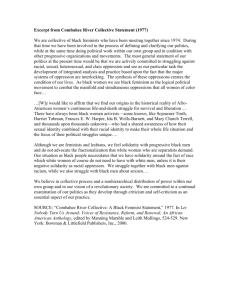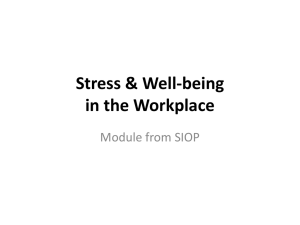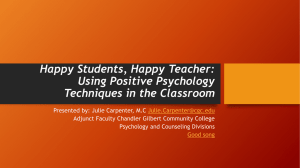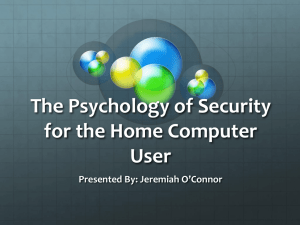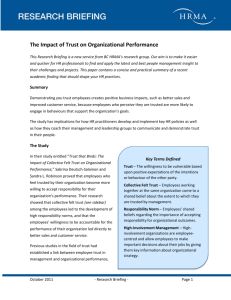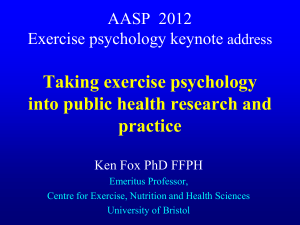Terms of Endearment*
advertisement
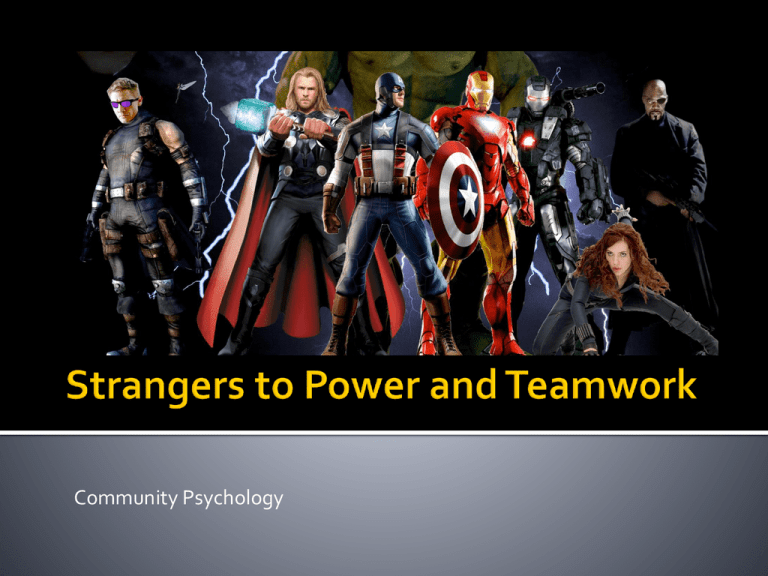
Community Psychology Think about the following situations: 1. A situation in which you experience a sense of community through bonding, close relationships and attachment 2. A time when you felt excluded and isolated 3. A situation in which you felt empowerment to do something or achieve something 4. An occasion in which you felt powerless and without a sense of control Rappaport introduced the concept of empowerment to indicate that power and control over community resources would be just as important as a feeling of communion Sense of Community: “the sense that one belongs in and is meaningfully a part of a larger collectivity; the sense that although there may be conflict between the needs of the individual and the collectivity, or among different groups in the collectivity, these conflicts must be resolved in a way that does not destroy the psychological sense of community; the sense that there is a network of and structure of relationships that strengthens rather than dilutes feelings of loneliness” (Sarason, 1988, p.41) Also known as “community cohesion” The potential of communities to improve the well-being of their members through the synergy of associations, mutual trust, sense of community, and collective action “Whereas physical capital refers to physical objects and human capital refers to properties of individuals, social capital refers to connections among individuals – social networks and the norms for reciprocity and trustworthiness that arise from them” (Putnam, 2000, p.19) Levels of Analysis Processes Outcomes Individual •Training in critical thinking •Participation in action groups •Mentoring experiences •Connecting with people in similar situations •Training in value-based practice •Consciousness-raising •Participation in social action •Assertiveness •Expanded options in life •Sense of Control •Mentoring Others Organizational •Shared leadership •Training in group facilitation •Participation in decision making •Sense of common purpose •Increased resources •Enhanced connections •Solidarity with other groups •Influences public opinion Community •Access to government •Participation in civic organizations •Political education •Target local issues •Improved quality of life •Enhanced health and well-being •Democratic institutions •Improved access to services •Coalitions for well-being •Tolerance of diversity Societal •Struggles for democracy •Struggles for liberation •Solidarity across social groups •Resisting globalization •Political and economic literacy •Redistributive policies •Support for disadvantaged people •Government accountability •Control of resources by the poor •Progressive social policies •Resists economic neoliberalism 1. 2. 3. 4. 5. 6. 7. 8. 9. 10. Power refers to the capacity and opportunity to fulfill or obstruct personal, relational, or collective needs Power has psychological and political sources, manifestations and consequences We can distinguish between power to strive for well-being, power to oppress, and power to resist oppression and strive for liberation Power can be overt or covert, subtle or blatant, hidden or exposed The exercise of power can apply to self, others, and collectives Power affords people multiple identities as individuals seeking wellbeing, engaging in oppression, or resisting domination Whereas people may be oppressed in one context, at a particular time and place, they may act as oppressors at another time and place Because of structural factors such as social class, gender, ability and race, people may enjoy different levels of power Degrees of power are also affected by personal and social constructs such as beauty, intelligence and assertiveness, constructs that enjoy variable status within different cultures The exercise of power can reflect varying degrees of awareness with respect to the impact of ones actions Sense of Community / Team Sense of Power Power to promote health and wellbeing Power to oppress and suppress Sense of Individual Liberty Sense of Equality Sense of Opportunity It’s still best to cross the street holding hands Partnerships and Solidarity (Team) Organizing to Solve One’s Own Community Issues at a Local Level Bonds and Bridging Social Capital can be directed in Adaptive or Maladaptive Methods, and sometimes both at the same time Too Much Power vs. Too Little Power “You gave me the power” – Bobby Ewing “No one gives you power. You TAKE power!” – Papa Ewing Being involuntarily disconnected from the economic and social mainstream of the society in which one lives: generally involves being discriminated against, being poor, having limited personal and collective power, and being excluded from social opportunities Symptoms of Marginalization Those who CHOOSE to be on the Margins Hobos, cults, communes, artists, poets, writers, philosophers, etc Those who DON’T CHOOSE to be on the Margins Immigrants, poor, mentally ill, illiterate, socially disapproved relationships Poverty and Economic Marginality Impaired Social Support Networks Including Social Marginalization Ideological Aspects Resistance and Resilience Thekaekara and Thekaekara (1995) “No matter what one has done occupationally… [once marginalized] …there is no way one can escape the experience of a social context that is like a stagnant pond in which we are the suffocating organisms. There is an absence of the social conditions that make optimism and hope a realistic life strategy.” Doyal and Gough (1984 and 1991) Two fundamental human needs: physical health and autonomy Autonomy: Autonomy of agency: the ability to initiate actions Critical autonomy: the opportunity for participation in political processes Are we arrogant enough to believe we can “show the way”? Is this the messiah complex all over again? What the heck to we know? Do we know that we do not know? Are we willing to be educated? Are we willing to let the marginalized lead us and teach us? Conscientization: a person or group achieve an illuminating awareness of social forces shaping their destiny and of their ability to transform that reality The human being is transformed through changing his or her reality, through an active process of dialogue 2. In this process, there is gradual decoding of the world, as people grasp the mechanisms of oppression and dehumanization. This opens up new possibilities for action 3. The new knowledge of the surrounding reality leads to new self-understanding. Such learning is about the roots of what people are present and what they can become in the future 1. What is our role as therapists? As citizens? As members of many intersecting communities? Do we have a role to play in the issues of Globalization? “Human survival and well-being [are] now embedded in an entangled web of global economic, political, social and environmental events and forces! …The scale, complexity and impact of these events and forces constitute a formidable challenge for psychology as a science and profession. They demand a major disciplinary response, including a rethinking of psychology’s assumptions, methods and interventions and a rethinking of psychology’s roles in understanding and resolving the challenges now before.” (Marsella, 1998, p.1282) Ideology: a system of ideas and practices that sustain social relations of domination and oppression Should we have an ideology? The Idea of Global Community Psychology Think Globally, Act Locally Engage / Develop Participatory Democracy Link Global Issues to Local Issues Protect Basic Human Rights “ – Anais Nin Share everything. Play fair. Don't hit people. Put things back where you found them. Clean up your own mess. Don't take things that aren't yours. Say you're sorry when you hurt somebody. Wash your hands before you eat. Flush. Warm cookies and cold milk are good for you. Live a balanced life Learn some and think some And draw and paint and sing and dance And play and work everyday some. Take a nap every afternoon. When you go out into the world, Watch out for traffic, Hold hands and stick together. Be aware of wonder. by Robert Fulghum Adaptation: how people adapt to the demands of different environments Behavior Setting: a way of thinking about settings that is characterized by a standing pattern of behavior and time and space dimensions Circular Causality: the notion that people influence environments, as well as environments influencing people Cycling of Resources: a focus on the resources within an ecosystem, how they are distributed and how they can be used Holism: a value that emphasizes interrelationships and interconnections Ecological Metaphor: a way of thinking about people and their environments that is borrowed from biology and stands in contrast to the mechanistic metaphor that is dominant in psychology Incidence: the number of new cases of disease in a population or community within a specified time period Interdependence: the notion that different elements and levels of an eco-system are interconnected Mediating Factors: the mechanisms that link stressful life events with psychosocial problems Miasmas: noxious odors emanating from swamps that were believed to cause disease Normalization: a philosophy in the field of disabilities that emphasizes approaches that promote community integration, rather than segregation or exclusion Person-Environment Fit: the idea that the adaptation of the individual is a function of the interaction between the individual and the environment Primary Prevention: Reduction of incidence Protective Factors: resources that moderate, buffer, or protect individuals from the adverse consequences of risk factors Risk Factors: stressful life events, the strains or other conditions that increase the likelihood that an individual will develop a problem in living Secondary Prevention: early detection and treatment Selective (high-risk) Prevention: prevention that is aimed at individuals considered to be at risk of developing problems Social Climate: the perceived or felt environment, consisting of three broad dimensions: relationships, personal development, and systems maintenance and change Succession: a long-term perspective on people and systems Universal Prevention: prevention that is aimed at everyone in a population Community: a group of people affiliated on the basis of common bonds, such as geographical location, religion, profession, nationality or other factors Power: the capacity and opportunity to influence the course of events in one’s personal life or in the life of others in the community Self-Help / Mutual Aid: groups of people who congregate in order to help each other with a particular challenge in life Sense of Community: the feeling derived from belonging to a particular group where the individual experience bonds of affection, influence, companionship, and support Social Capital: collective resources consisting of civic participation, networks, norms of reciprocity and organizations that foster trust among citizens and actions to enhance the common good Stress-Buffering Hypothesis: theory describing how social support may enhance coping and mitigate the negative effects of stress Fatalism: the attitude or belief that one has little influence over what happens to one personally or to one’s people Naturalized: used to indicate (implicit or explicit) the suggestion that a phenomenon which as a social origin is regarded as either a natural or innate characteristic of a people Neoliberal(ism): refers to the doctrine of the prime importance of the market in ordering society and defining value. Associated with policies that reduce state spending on health, education, and welfare, and constrain trade union and collective rights and freedom Phenomenological: to do with personal, felt experience. Knowable through qualitative, participative and non-reductionist methods of inquiry Praxis: the combination of theory and practice, each feeding the other. Usually implies a radical orientation
